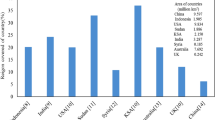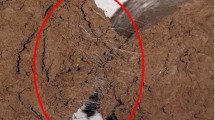Abstract
A laboratory study was carried out to evaluate the effect of lime, nano-zeolite, and polypropylene fibers on EC, pH, unconfined compressive strength (UCS), E50, Eu, and indirect tensile strength (ITS) of kaolin clay cured at the temperatures of 20 and 40 °C after various treatment times. Furthermore, X-ray diffractometer (XRD) and scanning electron microscopy (SEM) analyses were performed to assess the microstructure of the stabilized/reinforced samples. Based on the results, the replacement of lime with nano-zeolite has a beneficial effect on mechanical characteristics. The addition of nanoparticles up to 40% replacement had the best efficiency on the strength of the stabilized samples, particularly at the temperature of 40 °C. So that the samples containing 10% lime with 40% replacement of nano-zeolite after 28 days of curing at 20 and 40 °C showed a compressive strength of about 20 and 7 times compared to that of kaolin clay. Increasing the amount of lime also increases the peak strain energy (Eu) and secant modulus (E50). Moreover, the incorporation of fibers, despite the slight decrease in compressive strength, shows a great ability to increase tensile strength and strain of the samples and, consequently, increase the Eu. The results of the XRD and SEM tests showed that the inclusion of additives in the kaolin clay altered the soil structure and form the calcium silicate hydrate (CSH) gels during the pozzolanic reaction.












Similar content being viewed by others
References
Afrasiabian A, Salimi M, Movahedrad M, Vakili AH (2019) Assessing the impact of GBFS on mechanical behaviour and microstructure of soft clay. Int J Geotech Eng 1–11
Al-Mukhtar M, Lasledj A, Alcover JF (2010) Behaviour and mineralogy changes in lime-treated expansive soil at 50°C. Appl Clay Sci 50:191–198. https://doi.org/10.1016/j.clay.2010.07.023
Amran YHM, Alyousef R, Alabduljabbar H, El-Zeadani M (2020) Clean production and properties of geopolymer concrete; A review J Clean Prod 251. https://doi.org/10.1016/j.jclepro.2019.119679
Aryal S, Kolay PK (2020) Long-term durability of ordinary Portland cement and polypropylene fibre stabilized kaolin soil using wetting–drying and freezing–thawing test. Int J Geosynth Ground Eng 6(1):1–15
Bahmani SH, Huat BBK, Asadi A, Farzadnia N (2014) Stabilization of residual soil using SiO2 nanoparticles and cement. Constr Build Mater 64:350–359
Consoli NC, Vendruscolo MA, Prietto PDM (2003) Behavior of plate load tests on soil layers improved with cement and fiber. J Geotech Geoenviron Eng 129:96–101
Correia AA, Oliveira PJV, Custódio DG (2015) Effect of polypropylene fibres on the compressive and tensile strength of a soft soil, artificially stabilised with binders. Geotext Geomembr 43(2):97–106
Cui H, Jin Z, Bao X et al (2018) Effect of carbon fiber and nanosilica on shear properties of silty soil and the mechanisms. Constr Build Mater 189:286–295
Di Sante M, Fratalocchi E, Mazzieri F, Pasqualini E (2014) Time of reactions in a lime treated clayey soil and influence of curing conditions on its microstructure and behaviour. Appl Clay Sci 99:100–109. https://doi.org/10.1016/j.clay.2014.06.018
Eltantawy IM, Arnold PW (1973) Reappraisal of ethylene glycol mono ethyl ether (EGME) method for surface area estimations of clays. J Soil Sci 24:232–238
EPA (1983) Process design manual: land application of municipal sludge. Res Lab EPA-625/1–83-016
Ghorbani A, Hasanzadehshooiili H, Mohammadi M, et al (2019) Effect of selected nanospheres on the mechanical strength of lime-stabilized high-plasticity clay soils Adv Civ Eng 2019
Ghosh D, Bhattacharyya KG (2002) Adsorption of methylene blue on kaolinite. Appl Clay Sci 20:295–300
Ghosh P, Kumar H, Biswas K (2016) Fly ash and kaolinite-based geopolymers: processing and assessment of some geotechnical properties. J Geotech Eng 10(4):377–386
Goodarzi AR, Akbari HR (2014) Assessing the anion type effect on the hydro-mechanical properties of smectite from macro and micro-structure aspects. Geomech Eng 7:183–200
Goodarzi AR, Salimi M (2015a) Effect of iron industry slags on the geotechnical properties and mineralogy characteristics of expansive clayey soils. Modares J Civ Eng 15:161–203
Goodarzi AR, Salimi M (2015b) Stabilization treatment of a dispersive clayey soil using granulated blast furnace slag and basic oxygen furnace slag. Appl Clay Sci 108:61–69
Goodarzi AR, Goodarzi SH, Akbari HR (2015) Assessing geo-mechanical and micro-structural performance of modified expansive clayey soil by silica fume as industrial waste. Iran J Sci Technol Trans Civ Eng 39:333–350
Goodarzi AR, Akbari HR, Salimi M (2016) Enhanced stabilization of highly expansive clays by mixing cement and silica fume. Appl Clay Sci 132–133:675–684. https://doi.org/10.1016/j.clay.2016.08.023
Goodarzian A, Ghasemipanah A, Moayed RZ, Niroumand H (2020) Influence of nanozeolite particles on improvement of clayey soil. Int J Geotech Geol Eng 14:40–48
Hájková P (2018) Kaolinite claystone-based geopolymer materials: effect of chemical composition and curing conditions. Minerals 8(10):444
Heah CY, Kamarudin H, Al Bakri AM, Bnhussain M, Luqman M, Nizar IK et al (2012) Study on solids-to-liquid and alkaline activator ratios on kaolin-based geopolymers. Constr Build Mater 35:912–922
Hendershot WH, Duquette M (1986) A simple barium chloride method for determining cation exchange capacity and exchangeable cations 1. Soil Sci Soc Am J 50:605–608
Khajeh A, Mola-Abasi H, Naderi Semsani S (2017) Parameters controlling tensile strength of zeolite-cemented sands. Sci Iran Trans A, Civ Eng
Khajeh A, Chenari RJ, Payan M (2019) A simple review of cemented non-conventional materials: soil composites. Geotech Geol Eng 1–22
Kiliç R, Küçükali Ö, Ulamiş K (2016) Stabilization of high plasticity clay with lime and gypsum (Ankara, Turkey). Bull Eng Geol Environ 75:735–744. https://doi.org/10.1007/s10064-015-0757-2
Kumar A, Gupta D (2016) Behavior of cement-stabilized fiber-reinforced pond ash, rice husk ash–soil mixtures. Geotext Geomembr 44:466–474
Liguori B, Caputo D, Iucolano F (2015) Fiber-reinforced lime-based mortars: effect of zeolite addition. Constr Build Mater 77:455–460
Liu Y, Wang Q, Liu S et al (2019) Experimental investigation of the geotechnical properties and microstructure of lime-stabilized saline soils under freeze-thaw cycling. Cold Reg Sci Technol 161:32–42. https://doi.org/10.1016/j.coldregions.2019.03.003
Liu J, Bu F, Bai Y, et al (2020) Study on engineering properties of sand strengthened by mixed fibers and polyurethane organic polymer. Bull Eng Geol Environ 1–14
Mohammadi M, Niazian M (2013) Investigation of nano-clay effect on geotechnical properties of Rasht clay. Int J Adv Sci Tech Res 3:37–46
Mola-Abasi H, Khajeh A, Naderi Semsani S (2018a) Variables controlling tensile strength of stabilized sand with cement and zeolite. J Adhes Sci Technol 32:947–962
Mola-Abasi H, Khajeh A, Naderi Semsani S (2018b) Effect of the ratio between porosity and SiO2 and Al2O3 on tensile strength of zeolite-cemented sands. J Mater Civ Eng 30:4018–4028
Ouhadi VR, Yong RN, Sedighi M (2006) Desorption response and degradation of buffering capability of bentonite, subjected to heavy metalcontaminants. Eng Geol 85(1–2):102–110
Paul A, Hussain M (2019) An experiential investigation on the compressibility behavior of cement-treated Indian peat. Bull Eng Geol Environ 1–15
Ranjbar N, Zhang M (2020) Fiber-reinforced geopolymer composites: a review. Cem Concr Compos 107:103498
Salimi M, Ghorbani A (2020) Mechanical and compressibility characteristics of a soft clay stabilized by slag-based mixtures and geopolymers. Appl Clay Sci 184:105390. https://doi.org/10.1016/j.clay.2019.105390
Salimi M, Ilkhani M, Vakili AH (2018) Stabilization treatment of Na-montmorillonite with binary mixtures of lime and steelmaking slag. Int J Geotech Eng. https://doi.org/10.1080/19386362.2018.1439294
Samarakoon MH, Ranjith PG, Rathnaweera TD, Perera MSA (2019) Recent advances in alkaline cement binders: a review. J Clean Prod 227:70–87. https://doi.org/10.1016/j.jclepro.2019.04.103
Saygili A, Dayan M (2019) Freeze-thaw behavior of lime stabilized clay reinforced with silica fume and synthetic fibers. Cold Reg Sci Technol 161:107–114. https://doi.org/10.1016/j.coldregions.2019.03.010
Seco A, Ramírez F, Miqueleiz L, García B (2011) Stabilization of expansive soils for use in construction. Appl Clay Sci 51:348–352. https://doi.org/10.1016/j.clay.2010.12.027
Tran KQ, Satomi T, Takahashi H (2018) Effect of waste cornsilk fiber reinforcement on mechanical properties of soft soils. Transp Geotech 16:76–84
Vakili AH, Ghasemi J, Selamat MR b et al (2018) Internal erosional behaviour of dispersive clay stabilized with lignosulfonate and reinforced with polypropylene fiber. Constr Build Mater 193:405–415. https://doi.org/10.1016/j.conbuildmat.2018.10.213
Vakili AH, Selamat MRB, Salimi M, Gararei SG (2019) Evaluation of pozzolanic Portland cement as geotechnical stabilizer of a dispersive clay. Int J Geotech Eng:1–8
Vakili AH, Shojaei SI, Salimi M et al (2020) Contact erosional behaviour of foundation of pavement embankment constructed with nanosilica-treated dispersive soils. Soils Found
Wang Z-F, Shen S-L, Yin Z-Y, Xu Y-S (2015) Rapid field evaluation of the strength of cement-stabilized clayey soil. Bull Eng Geol Environ 74:991–999
Wang H-S, Tang C-S, Gu K et al (2020a) Mechanical behavior of fiber-reinforced, chemically stabilized dredged sludge. Bull Eng Geol Environ 79:629–643
Wang Y, Liu X, Zhang W, Li Z, Zhang Y, Li Y, Ren Y (2020b) Effects of Si/Al ratio on the efflorescence and properties of fly ash based geopolymer. J Clean Prod 244:118852. https://doi.org/10.1016/j.jclepro.2019.118852
Xia W-Y, Feng Y-S, Du Y-J et al (2018) Solidification and stabilization of heavy metal–contaminated industrial site soil using KMP binder. J Mater Civ Eng 30:4018080
Yusuf MO, Johari MAM, Ahmad ZA, Maslehuddin M (2014) Strength and microstructure of alkali-activated binary blended binder containing palm oil fuel ash and ground blast-furnace slag. Constr Build Mater 52:504–510
Zhang J, Soltani A, Deng A, Jaksa MB (2019) Mechanical performance of jute fiber-reinforced micaceous clay composites treated with ground-granulated blast-furnace slag. Materials (Basel) 12:576
Zhao Y, Xiao Z, Fan C, et al (2020) Comparative mechanical behaviors of four fiber-reinforced sand cemented by microbially induced carbonate precipitation. Bull Eng Geol Environ 1–12
Author information
Authors and Affiliations
Corresponding author
Rights and permissions
About this article
Cite this article
Akbari, H.R., Sharafi, H. & Goodarzi, A.R. Effect of polypropylene fiber inclusion in kaolin clay stabilized with lime and nano-zeolite considering temperatures of 20 and 40 °C. Bull Eng Geol Environ 80, 1841–1855 (2021). https://doi.org/10.1007/s10064-020-02028-x
Received:
Accepted:
Published:
Issue Date:
DOI: https://doi.org/10.1007/s10064-020-02028-x




